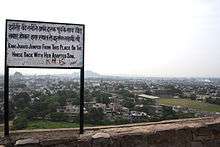Jhansi Fort
Jhansi Fort or Jhansi ka Kila is a fortress situated on a large hilltop called Bangira, in Uttar Pradesh, Northern India. It served as a stronghold of the Chandela Kings in Balwant Nagar from the 11th through the 17th century.
History
In 1728, Mohammed Khan Bangash attacked Chattrasal. Shrimant Bajirao Peshve helped Maharaja Chattrasal defeat the Mughal army. As a mark of gratitude, Maharaja Chattrasal offered a part of his state, which included Jhansi, to Shrimant Bajirao Peshve . In 1742 Naroshanker was made the subedar of Jhansi. During his tenure of 15 years he not only extended the strategically important Jhansi fort (the extension is called Shankergarh), but also constructed other buildings. In 1757, after Naroshanker was called back by the Peshwa. Madhav Govind Kakirde and then Babulal Kanahai were made the subedars of Jhansi. From 1766 to 1769 Vishwas Rao Laxman served as the subedar of Jhansi. Then Raghunath Rao (II) Newalkar was appointed the subedar of Jhansi. He was a very able administrator, increasing the revenue of the state and building both the MahaLakshmi Temple and the Raghunath Temple.
After the death of Shiv Rao his grandson Ramchandra Rao was made subedar of Jhansi. His poorly administered term ended with is death in 1835. His successor Raghunath Rao (III) died in 1838. The British rulers then accepted Gangadhar Rao as the Raja of Jhansi. The inefficient administration of Raghunath Rao (III) left Jhansi in a very poor financial position.


However, he was succeeded by Raja Gangadhar Rao, who was a very good administrator. He was reportedly very generous and sympathetic, and the local population of Jhansi was well satisfied. In 1842 Raja Gangadhar Rao married Manikarnika Tambe who was the given the new name of Lakshmi Bai. Lakshmi Bai ruled Jhansi after the death of her husband and used the fort as her residence. In 1858 she led Jhansi forces against those of the British East India Company.
Jhansi was besieged by the company forces of General Hugh Rose in March and April 1858 and was captured on 4 April 1858. Rani Lakshmi Bai was able to make a daring escape on horseback from the fort and the city before the city was pillaged by Rose's troops.[1]
In 1861 the British Government gave the Jhansi fort and Jhansi city to Jiyaji Rao Scindia, the Maharaja of Gwalior, but the British took back Jhansi from Gwalior state in 1868.
Structure

The fort standing in the hilly area shows how the north Indian style of fort construction differs from that of the south. In the south most of the forts were built on the sea beds like Bekal Fort in Kerala. The granite walls of the fort are between 16 and 20 feet thick and on the south side meet the city walls. The south face of the fort is almost perpendicular.[2] There are 10 gates giving access to the fort. Some of these are Khanderao Gate, Datia Darwaza, Unnao Gate, Jharna Gate, Laxmi Gate, Sagar Gate, Orchha Gate, Sainyar Gate and Chand Gate. Notable sights in the fort are the Shiva temple, Ganesh temple at the entrance, and the Kadak Bijli cannon used in the uprising of 1857. The memorial board reminds one of the hair-raising feat of the Rani Lakshmibai in jumping on horseback from the fort. Nearby is the Rani Mahal, built in the later half of the 19th century where there is now an archaeological museum.
The fort extends to a sprawling 15 acres (61,000 m2) and this colossal structure measures about 312m in length and 225m in width. On the whole, there are twenty-two supports with a mammoth strengthening wall surrounded by a moat on both sides. The shattered upholder on the eastern side was rebuilt by the British, who also added a floor to Panch Mahal.
Events
Every year in the month of January–February a grand occasion is held known as Jhansi Mahotsav when many eminent personalities and artists perform their play.
See also
References
External links
| Wikimedia Commons has media related to Jhansi Fort. |
Coordinates: 25°27′29″N 78°34′32″E / 25.45809°N 78.57544°E